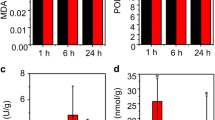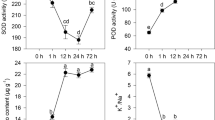Abstract
We investigated the transcriptional response of Burma mangrove (Bruguiera gymnorhiza) to high salinity (salt stress; 500 mM NaCl) and hyperosmotic stress (osmotic stress; 1 M sorbitol) by microarray analysis. ANOVA (P < 0.05) and significant analysis of microarray (SAM; FDR < 5%) revealed that 865 of 11,997 genes showed significant differential expression under salt and osmotic stress. Scatter plot analysis revealed that the expression level of genes changed at 6 h after salt stress treatment, but recovered at 24 h, while the change at 6 h after osmotic stress treatment diverged at 24 h. Hierarchical clustering of the 865 genes showed that expression profiles under salt stress were distinctly different from those under osmotic stress. Comparison of gene ontology (GO) categories of differentially expressed genes under the stress conditions revealed that the adaptation of Burma mangrove to salt stress was accompanied by the up-regulation of genes categorized for “cell communication,” “signal transduction,” “lipid metabolic process,” “photosynthesis,” “multicellular organismal development,” and “transport,” and by down-regulation of genes categorized for “catabolic process.” Burma mangrove maintained its leaf water potential and recovered from its photosynthesis rate that declined temporarily under salt stress, but not under osmotic stress. These results demonstrated a fundamental difference between the response to salt and osmotic stress. Ion and sugar content analysis suggested that salt tolerance of Burma mangrove might be attributed to their ability to accumulate high concentrations of Na+ and Cl−, even under non-stressed conditions; to uptake additional Na+ and Cl− for use as osmolytes; and to maintain K+ homeostasis under salt stress.









Similar content being viewed by others

Abbreviations
- ANOVA:
-
Analysis of variance
- EST:
-
Expressed sequence tag
- FDR:
-
False discovery rate
- GO:
-
Gene ontology
- SAM:
-
Significant analysis of microarray
References
Abebe T, Guenzi AC, Martin B, Cushman JC (2003) Tolerance of mannitol-accumulating transgenic wheat to water stress and salinity. Plant Physiol 131:1748–1755
Apse MP, Aharon GS, Snedden WA, Blumwald E (1999) Salt tolerance conferred by overexpression of a vacuolar Na+/H+ antiport in Arabidopsis. Science 285:1256–1258
Banzai T, Hershkovits G, Katcoff DJ, Hanagata N, Dubinsky Z, Karube I (2002a) Identification and characterization of mRNA transcripts differentially expressed in response to high salinity by means of differential display in the mangrove, Bruguiera gymnorrhiza. Plant Sci 162:499–505
Banzai T, Sumiya K, Hanagata N, Dubinsky Z, Karube I (2002b) Molecular cloning and characterization of genes encoding BURP domain-containing protein in the mangrove, Bruguiera gymnorrhiza. Trees 16:87–93
Banzai T, Hanagata N, Dubinsky Z, Karube I (2003) Fructose-2,6-bisphosphate contents were increased in response to salt, water and osmotic stress in leaves of Bruguiera gymnorhiza by differential changes in the activity of the bifunctional enzyme 6-phosphofructo-2-kinase/fructose-2,6-bisphosphate 2-phosphatase. Plant Mol Biol 53:51–59
Blumwald E (2000) Sodium transport and salt tolerance in plants. Curr Opin Cell Biol 12:431–434
Blumwald E, Aharon GS, Apse MP (2000) Sodium transport in plant cells. Biochim Biophys Acta 1465:140–151
Bolstad BM, Irizarry RA, Astrand M, Speed TP (2003) A comparison of normalization methods for high density oligonucleotide array data based on variance and bias. Bioinformatics 19:185–193
Cheng NH, Pittman JK, Zhu JK, Hirschi KD (2004) The protein kinase SOS2 activates the Arabidopsis H+/Ca2+ antiporter CAX1 to integrate calcium transport and salt tolerance. J Biol Chem 279:2922–2926
Chinnusamy V, Schumaker K, Zhu JK (2004) Molecular genetic perspectives on cross-talk and specificity in abiotic stress signalling in plants. J Exp Bot 55:225–236
Eisen MB, Spellman PT, Brown PO, Botstein D (1998) Cluster analysis and display of genome-wide expression patterns. Proc Natl Acad Sci U S A 95:14863–14868
FAO (2005) Global network on integrated soil management for sustainable use of salt-affected soils, vol 61. FAO Land and Plant Nutrition Management Service, Rome, Italy http://www.fao.org/ag/agl/agll/spush
Flowers T, Troke PF, Yeo AR (1977) The mechanisms of salt tolerance in halophytes. Ann Rev Plant Physiol 29:89–121
Hasegawa PM, Bressan RA, Zhu JK, Bohnert HJ (2000) Plant cellular and molecular responses to high salinity. Annu Rev Plant Physiol Plant Mol Biol 51:463–499
Huber W, von Heydebreck A, Sultmann H, Poustka A, Vingron M (2002) Variance stabilization applied to microarray data calibration and to the quantification of differential expression. Bioinformatics 18(Suppl 1):S96–104
Knight H, Knight MR (2001) Abiotic stress signalling pathways: specificity and cross-talk. Trends Plant Sci 6:262–267
Liu J, Zhu JK (1998) A calcium sensor homolog required for plant salt tolerance. Science 280:1943–1945
Miyama M, Hanagata N (2007a) Microarray analysis of 7029 gene expression patterns in burma mangrove under high-salinity stress. Plant Sci 172:948–957
Miyama M, Hanagata N (2007b) Microarray gene expression profiling for salt tolerant gene selection. Plant Stress 1:118–122
Miyama M, Shimizu H, Sugiyama M, Hanagata N (2006) Sequencing and analysis of 14,842 expressed sequence tags of burma mangrove, Bruguiera gymnorrhiza. Plant Sci 171:234–241
Ohta M, Hayashi Y, Nakashima A, Hamada A, Tanaka A, Nakamura T, Hayakawa T (2002) Introduction of a Na+/H+ antiporter gene from Atriplex gmelini confers salt tolerance to rice. FEBS Lett 532:279–282
Ottow EA, Brinker M, Teichmann T, Fritz E, Kaiser W, Brosche M, Kangasjarvi J, Jiang X, Polle A (2005) Populus euphratica displays apoplastic sodium accumulation, osmotic adjustment by decreases in calcium and soluble carbohydrates, and develops leaf succulence under salt stress. Plant Physiol 139:1762–1772
Park JM, Park CJ, Lee SB, Ham BK, Shin R, Paek KH (2001) Overexpression of the tobacco Tsi1 gene encoding an EREBP/AP2-type transcription factor enhances resistance against pathogen attack and osmotic stress in tobacco. Plant Cell 13:1035–1046
Popp M, Larher F, Weigel P (1985) Osmotic adaption in Australian mangroves. Plant Ecol 61:247–253
Rozen S, Skaletsky H (2000) Primer3 on the WWW for general users and for biologist programmers. Methods Mol Biol 132:365–386
Saeed AI, Sharov V, White J, Li J, Liang W, Bhagabati N, Braisted J, Klapa M, Currier T, Thiagarajan M, Sturn A, Snuffin M, Rezantsev A, Popov D, Ryltsov A, Kostukovich E, Borisovsky I, Liu Z, Vinsavich A, Trush V, Quackenbush J (2003) TM4: a free, open-source system for microarray data management and analysis. Biotechniques 34:374–378
Sakamoto A, Murata A, Murata N (1998) Metabolic engineering of rice leading to biosynthesis of glycinebetaine and tolerance to salt and cold. Plant Mol Biol 38:1011–1019
Sheveleva E, Chmara W, Bohnert HJ, Jensen RG (1997) Increased salt and drought tolerance by d-ononitol production in transgenic Nicotiana tabacum L. Plant Physiol 115:1211–1219
Sugihara K, Hanagata N, Dubinsky Z, Baba S, Karube I (2000) Molecular characterization of cDNA encoding oxygen evolving enhancer protein 1 increased by salt treatment in the mangrove Bruguiera gymnorrhiza. Plant Cell Physiol 41:1279–1285
Takemura T, Hanagata N, Sugihara K, Baba S, Karube I, Dubinsky Z (2000) Physiological and biochemical responses to salt stresses in the mangrove, Bruguriera gymnorrhiza. Aquat Bot 68:15–28
Takemura T, Hanagata N, Dubinsky Z, Karube I (2002) Molecular characterization and response to salt stress of mRNAs encoding cytosolic Cu/Zn superoxide dismutase and catalase from Bruguiera gymnorrhiza. Trees 16:94–99
Troyanskaya O, Cantor M, Sherlock G, Brown P, Hastie T, Tibshirani R, Botstein D, Altman RB (2001) Missing value estimation methods for DNA microarrays. Bioinformatics 17:520–525
Tusher VG, Tibshirani R, Chu G (2001) Significance analysis of microarrays applied to the ionizing radiation response. Proc Natl Acad Sci U S A 98:5116–5121
Xu D, Duan X, Wang B, Hong B, Ho T, Wu R (1996) Expression of a late embryogenesis abundant protein gene, hva1, from barley confers tolerance to water deficit and salt stress in transgenic rice. Plant Physiol 110:249–257
Yamaguchi T, Blumwald E (2005) Developing salt-tolerant crop plants: challenges and opportunities. Trends Plant Sci 10:615–620
Zhu JK (2001) Plant salt tolerance. Trends Plant Sci 6:66–71
Zhu JK (2002) Salt and drought stress signal transduction in plants. Annu Rev Plant Biol 53:247–273
Zhu JK (2003) Regulation of ion homeostasis under salt stress. Curr Opin Plant Biol 6:441–445
Acknowledgments
We thank Noriko Someya for her excellent technical assistance. This work was supported by MEXT (the Ministry of Education, Culture, Sports, Science and Technology of Japan), “University-Industry Joint Research” Project 2003–2007.
Author information
Authors and Affiliations
Corresponding author
Electronic supplementary material
Below is the link to the electronic supplementary material.
Rights and permissions
About this article
Cite this article
Miyama, M., Tada, Y. Transcriptional and physiological study of the response of Burma mangrove (Bruguiera gymnorhiza) to salt and osmotic stress. Plant Mol Biol 68, 119–129 (2008). https://doi.org/10.1007/s11103-008-9356-y
Received:
Accepted:
Published:
Issue Date:
DOI: https://doi.org/10.1007/s11103-008-9356-y



